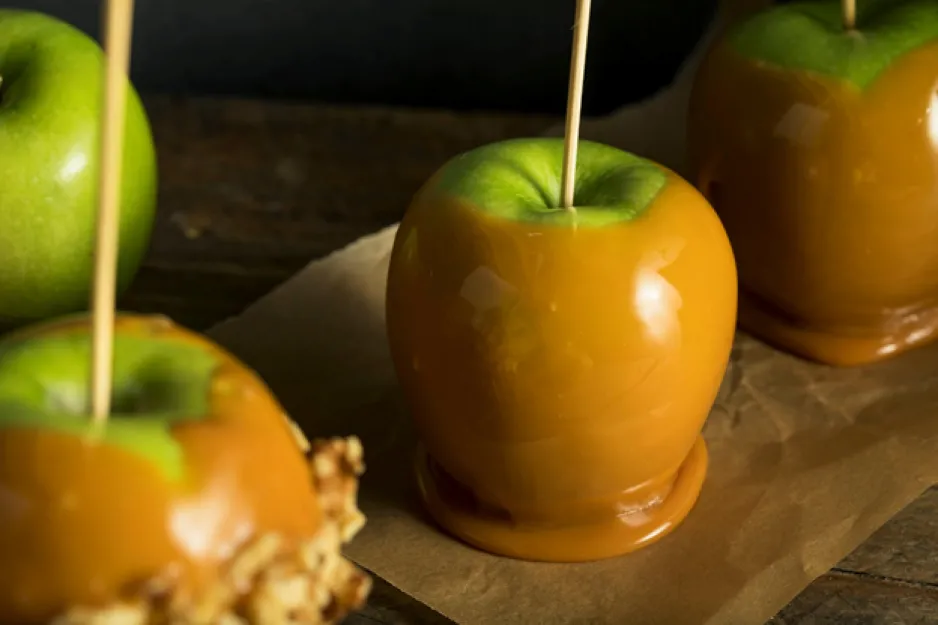3 things you should know about how the DART spacecraft changed the orbit of an asteroid, how we have more than five senses, and how the science of caramel can make you a better cook!

Meet Cassandra Marion, Renée-Claude Goulet, and Michelle Campbell Mekarski.
They are Ingenium’s science advisors, providing expert scientific advice on key subjects relating to the Canada Aviation and Space Museum, the Canada Agriculture and Food Museum, and the Canada Science and Technology Museum.
In this colourful monthly blog series, Ingenium’s science advisors offer up quirky nuggets related to their areas of expertise. For the October edition, they explain how the DART spacecraft changed the orbit of an asteroid millions of kilometers from Earth, how we have many more than five senses, and how the science of caramel can make you a better cook.

The DART spacecraft’s impact into the asteroid Dimorphos, ejecting rock and dust into space, as captured by LICIACube.
DART spacecraft has successfully changed the orbit of an asteroid!
For the first time, humans have changed the orbit of a planetary body – an achievement that may benefit us all.
In September 2022, the Double Asteroid Redirection Test (DART) mission’s spacecraft intentionally crashed into a small asteroid’s moon in an attempt to change its trajectory. After two weeks of monitoring, the results have far exceeded expectations. The asteroid Dimorphos’s orbital period – the time it takes complete one orbit around its parent asteroid – was reduced by 32 minutes, or 4 percent.
The DART spacecraft was about the size of a refrigerator (1.3 m long) and impacted the 160 m wide Dimorphos which orbits around the 780 m wide Didymos. The 600 kg spacecraft impacted at a speed of 22,530 km/hr. The impact was observed and captured by both the DART spacecraft’s own camera, DRACO; the Italian Space Agency’s LICIACube – a tiny cube satellite launched alongside DART; the Hubble and James Webb space telescopes; and by a series of ground-based telescopes on Earth.
The first observations of the impact were amazing! Before it was destroyed by impact, the DRACO camera returned the first close-up image of the asteroid’s boulder-rich surface. Footage from LICIACube, as well as from James Webb and Hubble, show a plume of material ejecting off Dimorphos and forming rays. With time, the ejecta material was streamlined into a comet-like tail some 9,500 km long. The tail’s properties keep changing and are being further monitored to better understand the phenomenon.
The change in orbital properties – the mission’s #1 objective – needed to be evaluated over a reasonable span of time from ground-based telescopes. The asteroid pair were observed over several weeks to conduct repeated calculations of the time it took for Dimorphos to orbit Didymos. Pre-impact, it took Dimorphos 11 hours and 55 minutes to complete one orbit. Post-impact, it took 11 hours, 52 minutes. Though the two asteroids are difficult to distinguish from the ground, when Dimorphos passes in front of, or behind Didymos, there is a measurable change in their combined or total brightness. When the time interval between the changes is measured, the orbital period can be determined.
Scientists will continue to observe this binary asteroid system to further understand Dimorphos’ orbital, physical and chemical properties, the crater formed by the impact, and the ejecta.
The DART test was completed as part of NASA’s planetary defense strategy: determining whether a kinetic impact – smashing something into an incoming asteroid – is a viable solution to mitigate the threat to Earth of a potentially hazardous asteroid in the future. Don’t worry, this asteroid is not currently on a path for our planet and there are currently no known large asteroids that pose an imminent threat. NASA’s Center for Near Earth Object Studies, in collaboration with other institutions around the globe, are constantly monitoring for potential threats.
By Cassandra Marion

We sense the world in more ways than we realize. Sight, smell, taste, sound, and touch are only the beginning.
How many senses do you actually have? Hint: It’s more than five!
How many senses do you have? Most people would probably say five: sight, sound, taste, touch, and smell. However, humans are capable of sensing much more than this.
We experience the world through our senses. They’re what alerts our brains that cookies might be burning in the oven, that a soft drink is sweet and fizzy, that a sunset is colourful, or that we have touched a hot pan.
Our brains receive all sensory information through a similar pathway. Specialized sensory cells receive some sort of stimulus, and transmit a signal through our nerves to our brains, where they are interpreted. We have many types of sensory cells that are grouped into categories depending on the type of stimulus they respond to.
Photoreceptors are sensory cells that detect light. Most photoreceptors are found in the eyes and are needed for your sense of sight. We have several types of photoreceptor cells in our eyes, including three types of cone cells which allow us to see in colour, and rod cells which help us see in low light conditions. More recently, researchers have discovered another type of photoreceptors called photosensitive retinal ganglion cells which seem to play a role in our circadian rhythms and melatonin production, and may contribute to our sense of time.
Chemoreceptors are sensory cells that react to certain chemicals. These are found mainly on our tongues and in our noses, providing our senses of taste and smell. We have hundreds of types of smell receptors, each of which responds to a specific molecule. We also have chemoreceptors in our blood vessels, which allows our bodies to sense the levels of carbon dioxide, sugar, water, and acidity in our blood.
Mechanoreceptors are cells that respond to mechanical forces like stretching, pressure, or vibration. We have several types of these throughout our skin which allow us to sense gentle touch, vibration, stretching, texture, and pain. Receptors that sense stretching in our bladder give us the sense of “I need to pee!” Sensitive mechanoreceptors in our inner ears can be stretched or compressed by gravity or sound waves, providing our senses of hearing, balance, and acceleration. Mechanoreceptors throughout our body and joints also give us our sense of proprioception, which makes our brains aware of the position and movement of our bodies – this is how you can touch your nose with your eyes closed.
Thermoreceptors are cells that respond to temperature. Some allow us to sense cold and others heat. Most are found in our skin, but some are found internally in our muscles, brain, and liver.
Counting exactly how many senses you have is a bit complicated. Some argue that each type of sensory cell should be counted as a separate sense. This would mean we have five ‘senses’ of sight and hundreds of ‘senses’ of smell. Even if we group these together, we still have senses like balance, proprioception, or temperature which are often forgotten. To complicate matters further, research into our senses is ongoing, with new types of sensory cells still being discovered (for example, a new type of sensory cell discovered in 2017 that detects the presence of water on our tongues).
So just how many senses do you have? The answer is still unknown, but it’s definitely more than five.
By Michelle Campbell Mekarski

The Maillard reaction is to thank for caramel toffee’s rich flavour and colour!
The science of caramel can make you a better cook!
October brings us Thanksgiving and Halloween, and consequently, lots of tasty treats! The bakers among us may be attempting an old favorite this year: caramel. Like everything else in cooking, there's a lot of chemistry involved in turning sugar crystals into a golden, sticky, tasty candy. The science of caramel can actually help us understand two very important chemical transformations in cooking and baking, which guarantee tasty results.
Now, not all caramels are the same. First, we have the thicker, chewy caramel often found wrapped up in bite-sized pieces, coated in chocolate or smothering our apples. And then, there’s the runnier kind, usually used as a sauce, topping, or filling.
Creamy, chewy caramels usually contain corn syrup and protein-rich cream, and all the ingredients are cooked together at a moderate heat. The Maillard reaction is the star here. “What is the Maillard reaction?” you ask. Kicking in at temperatures between 140 to 165°C (280 to 330°F) it’s the browning and flavour-making reaction, and it’s everywhere in cooking. It’s the difference between steamed and stir-fried vegetables, or boiled and grilled meat. It happens when we toast nuts, bake bread, or roast grains to make malt for beer brewing — foods that are all delicious-smelling and tasting. Chemically speaking, it's when sugars and protein building blocks – amino acids – react together under heat to create brown substances called melanoidins, and a host of flavour and odor compounds.
The second kind of caramel, which starts with a base of caramelized sugar, is arguably trickier to get right. This is because caramelization is much more difficult to control than the Maillard reaction.
Caramelization starts at a higher temperature, about 160°C (320°F), where sugar melts. This process requires careful attention to gauge timing to prevent burning. During caramelization, sugars get broken apart and rearranged into smaller compounds, producing lots of aroma molecules - or odours - and pigments called caramelans. In this reaction, there are no amino acids for the sugar to interact with. Caramelization is more like slowly burning the sugar molecules, which is why it’s easy to overdo it and accidentally create bitter flavours.
In caramel candy and sauce, both reactions can come into play at different levels of intensity and at different times, so what really matters for caramel success is temperature control, and the right ingredients at the right time for what you are trying to achieve.
How we come to different products from the same ingredients demonstrates well why candy-making can be quite finicky - no substitutions allowed! Now that you know a bit more about the two famous food browning and flavour-making reactions, why not experiment with your recipes and see if you can apply the same science to up the flavour and aroma of your dishes!
By Renée-Claude Goulet
Enjoying the Ingenium Channel? Help us improve your experience with a short survey!






































